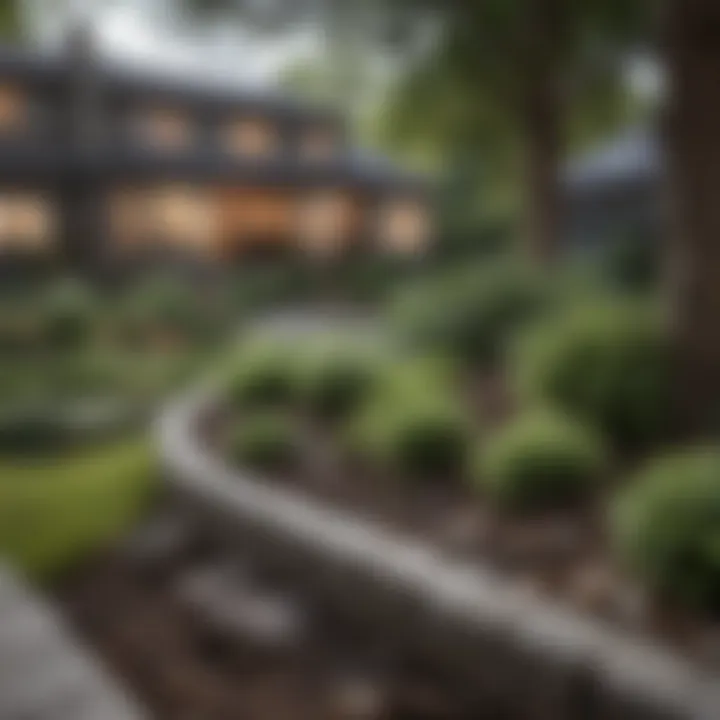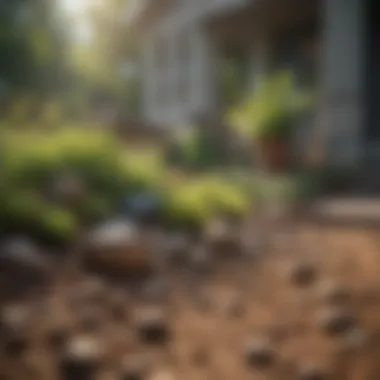Understanding Average Landscaping Costs: A Detailed Guide


Intro
Landscaping is not simply about aesthetics; it involves strategic decisions that affect the overall appeal and functionality of a property. Many homeowners consider landscaping as a significant investment, which makes understanding the financial aspects paramount. This analysis will help readers grasp the average prices associated with various landscaping services. By breaking down essential tasks, pricing factors, and regional differences, homeowners and gardening enthusiasts can make informed choices when planning their landscaping projects.
Design Inspiration
Landscaping design is influenced by current trends and the unique character of a property. Without a clear vision, projects can easily exceed budgets and fail to meet expectations. Homeowners should seek inspiration to create designs that reflect their personal style and enhance property value.
Current Trends in Landscaping
These days, sustainability plays a vital role in landscaping. Homeowners lean towards native plant selections and environmentally friendly materials. The integration of hardscapes like patios and walkways is also popular, creating functional outdoor living spaces. Customers increasingly prefer low-maintenance gardens that require less water and upkeep.
Color Schemes and Palette Ideas
When considering colors in landscaping, it is essential to think about the seasonal variations in plant life. Plants such as lavender or daylilies provide vibrant colors during spring and summer, while evergreens maintain their hue year-round. A well-balanced palette enhances the visual impact and creates a harmonious environment.
Factors Influencing Pricing
Numerous factors shape the costs associated with landscaping services. Understanding these elements can guide homeowners in budgeting effectively.
- Size of the area: The larger the space, the higher the material and labor costs.
- Type of plants and materials: Rare species or premium materials tend to be considerably more expensive.
- Complexity of design: Intricate designs require more planning and implementation, often increasing labor costs.
- Labor: Skilled labor can significantly impact overall expenses. Rates may vary by region and project scope.
The cost of landscaping can range markedly, with average price points differing across regions and project types. Awareness of these can lead to better financial decisions.
Landscaping Tasks and Their Average Costs
Homeowners must recognize that different tasks command varying prices. Some common landscaping services include:
- Lawn Installation: Ranges from $0.50 to $2.00 per square foot, depending on grass type and installation method.
- Tree Planting: The average cost can range from $150 to $1,000 depending on tree size and species.
- Mulching: Typically costs between $75 to $150 per cubic yard.
- Patio Installation: Pricing starts around $1,000 for basic materials and can exceed $5,000 for intricate designs.
Regional Variations
It is critical to understand that prices fluctuate greatly based on geographical factors. Regions with higher labor costs or expensive materials will generally see increased landscaping prices. For instance, urban areas often command higher rates compared to rural locations. Homeowners in coastal regions may face additional fees related to specific material selection, considering saltwater exposure and weather conditions. This analysis should empower homeowners to research local costs, allowing for fine-tuning their budgets accordingly.
Culmination
Landscaping encompasses a variety of services with different price points determined by several factors. By understanding average costs, homeowners can navigate the financial landscape of their projects more effectively. Proper planning and knowledge enable informed decisions that enhance both residential landscapes and overall property values.
Preface to Landscaping Costs
Landscaping is an integral part of property management that can enhance the aesthetic value of a home while increasing its overall worth. Understanding landscaping costs is essential for homeowners and gardening enthusiasts alike. Being informed about these costs allows individuals to budget effectively, select the right services, and understand where their money is going. Moreover, this comprehension can serve as a springboard for making strategic decisions that align with both anticipated outcomes and financial capabilities.
Defining Landscaping
Landscaping involves any activity that alters the visible features of an area of land. This can include a variety of tasks such as planting flora, installing hardscape elements like patios and pathways, and creating structures that provide shade or visual interest. Landscaping can also extend to maintaining these features over time to ensure that they remain healthy and appealing. It is not merely a one-time project but a continuous process that can include numerous aspects tailored to the needs of individual homeowners.
The Importance of Landscaping
Landscaping is vital for several reasons. It significantly contributes to the curb appeal of a property, giving a pleasing first impression to guests and potential buyers. Furthermore, well-executed landscaping can enhance the functionality of outdoor spaces. For instance, appropriate planting can offer shade, while hardscaping can create usable areas for relaxation or entertainment.
Additionally, good landscaping practices can promote environmental health. Native plants, for example, require less maintenance and are better suited for local climates, reducing water usage in landscaping. Not only does this lead to cost savings over time, but it also contributes positively to the local ecosystem.
Factors Influencing Landscaping Prices
Understanding the various elements that affect landscaping prices is crucial for homeowners. Landscaping is not merely about planting flowers or putting down sod; it encompasses a complex blend of services that can vary widely in cost. Hence, knowing what influences these costs can help in making informed decisions about your landscaping investments.


Size of the Property
The size of the property plays a significant role in determining landscaping prices. A larger area typically requires more materials, labor, and time, which directly impacts the overall cost. For instance, installing a lawn on a small city lot is considerably less expensive than landscaping a sprawling estate. Moreover, larger projects may necessitate specialized equipment and more skilled labor, further driving up costs.
Type of Landscaping Services
Different landscaping services come with varying price tags. Basic tasks such as lawn mowing or weeding are generally less expensive than installing intricate features like patios, pools, or outdoor kitchens. When choosing your services, consider what you want to achieve. A simple garden bed might only require moderate investment, while a complete landscape redesign could involve significant financial commitment.
Geographic Location
Geographic location is another critical factor. Landscape firms in urban areas may charge higher fees due to increased demand and operational costs compared to those in rural regions. Moreover, the climate can influence what plants are available, their cost, and the necessary infrastructure such as irrigation systems. Therefore, knowing your local market and its trends can provide valuable insights into pricing.
Seasonal Considerations
Seasonality greatly affects landscaping prices. During peak seasons, such as spring and early summer, both demand and prices typically rise. Many homeowners rush to complete their projects, which may lead to higher labor costs as firms become busy. Conversely, off-season work can often be more economical as services may offer discounts to attract clients. Depending on the timing, significant savings can be realized by scheduling projects during slower periods.
Average Pricing for Common Landscaping Tasks
Understanding the average pricing for common landscaping tasks is essential for homeowners and gardening enthusiasts. Cost transparency helps individuals budget appropriately, ensuring positive outcomes for their landscaping projects. Knowing the price range for various services enables clients to compare quotes from landscapers effectively and avoid unexpected financial surprises. This section highlights popular landscaping tasks and their typical costs, creating a clear roadmap for planning these enhancements.
Lawn Installation
Lawn installation is often one of the first tasks homeowners consider when rejuvenating their outdoor spaces. The average cost for this service varies based on several factors, including the size of the area, type of grass, and installation method. Per square foot, costs can range from $0.50 to $2.00 for sod installation and even lower for grass seed. One major benefit of laying sod is the instant effect it provides. However, this method may require a larger upfront investment compared to seeding. Ultimately, lawn installation creates a foundation for further landscaping enhancements.
Garden Bed Installation
Garden bed installation allows for personalization in a landscape design. The average pricing falls between $3 and $10 per square foot, depending on size and materials chosen. Furthermore, the complexity of design also impacts costs. Established garden beds can elevate the visual appeal of a yard. Additionally, they can significantly contribute to efficient plant growth by improving soil quality. Such features create functional yet attractive spaces, making garden bed installation a wise investment.
Hardscaping Services
Hardscaping refers to non-plant elements of landscaping, including patios, walkways, and retaining walls. These services generally require more labor and material, resulting in higher costs compared to soft landscaping. Each aspect serves a unique purpose in enhancing outdoor functionality and aesthetics.
Patios
Patios provide an excellent area for outdoor gatherings and relaxation. Installation costs can range from $8 to $30 per square foot, depending on materials and complexity. The key characteristic of patios is their versatility; they can be made from various materials, such as concrete, pavers, or stone. Patios integrate well with existing landscapes, making them a popular choice. However, proper drainage must be considered during installation to avoid water buildup.
Walkways
Walkways serve both practical and aesthetic functions in landscaping. They guide movement through the garden and prevent soil erosion. Installation costs typically range from $5 to $25 per square foot. The appeal of walkways lies in their potential design, which can complement the surrounding environment. A downside is that while they are durable, they may require occasional maintenance to keep them in good condition.
Retaining Walls
Retaining walls provide structural support and help manage changing elevations in a landscape. Their prices can range from $10 to $50 per square foot based on material and design complexity. One primary benefit of retaining walls is their ability to prevent soil erosion and maintain landscape integrity. Additionally, they can be designed aesthetically, adding visual interest to the outdoor space. However, improper installation can lead to issues with stability, so hiring qualified professionals is crucial.
Planting Trees and Shrubs
Planting trees and shrubs enhances biodiversity and visual appeal in a landscape. The ahdverage costs vary significantly based on the size and type of plants chosen. Smaller shrubs may cost around $10 to $30, while large trees can exceed $100. Selecting appropriate plants for the local climate and soil conditions is essential for ensuring their longevity and health. This investment not only improves aesthetics but contributes to the environment.
Irrigation Systems
Irrigation systems are vital for sustaining plant life in landscaping. Costs typically range from $1,500 to $3,000 for a standard system, depending on property size and required complexity. Opting for an automated irrigation system can save time and ensure consistent watering. A well-designed system helps prevent water waste, making it environmentally friendly. However, regular maintenance is necessary to keep it functioning efficiently.
Understanding these average costs for common landscaping tasks helps homeowners plan their projects better. This knowledge allows for informed decisions and realistic expectations, facilitating the creation of beautiful and functional outdoor spaces.
Labor Costs in Landscaping
Labor costs are a significant component of any landscaping project. Understanding these costs helps homeowners allocate their budgets effectively and ensure that they receive quality service. The complexities of labor costs can greatly impact the overall expense of landscaping. It's essential to distinguish between various aspects of these costs to make the best decisions when hiring a landscaping service.


Average Hourly Rates
Average hourly rates for landscaping labor vary widely based on several factors such as geographic location, company reputation, and experience of the workers. On average, rates can range from $25 to $75 per hour. In urban areas, where the demand for landscaping is higher, you might see rates at the higher end or even above. Rural areas often present lower costs, but the trade-off may include fewer options for qualified labor. Knowing these averages helps homeowners set realistic expectations for their project.
Factors Affecting Labor Costs
Several factors influence the labor costs in landscaping:
- Experience of Workers: Highly skilled landscapers command higher hourly rates. Their expertise often results in better quality work, which can make the cost worth it.
- Complexity of the Work: Simple tasks, like lawn mowing, tend to be less costly compared to more intricate jobs such as installing a hardscape feature. Intricate tasks require more time and skill, leading to higher labor charges.
- Regional Differences: Labor costs can significantly vary from one region to another. A landscaping job in New York may cost more than a similar job in Kentucky.
- Seasonality: Wage rates can also fluctuate with seasons. In peak seasons, labor might be more expensive due to high demand for landscaping services.
Understanding labor costs is essential for budgeting in landscaping. It allows homeowners to plan adequately and avoid unexpected expenses.
Additionally, factors like the type of landscaping service requested, possible need for specialized equipment, and any necessary permits can all contribute to labor costs. Being informed about these considerations will empower homeowners to negotiate effectively and ensure they receive fair and quality service for their investment.
Material Costs in Landscaping
Material costs play a crucial role in landscaping projects. Understanding these costs helps homeowners make informed decisions. Selecting the right materials directly influences the overall budget and the longevity of landscaping features. Quality materials can enhance the aesthetic appeal of a property while also ensuring sustainability and durability.
Choosing materials requires careful consideration of various factors. These include cost, availability, maintenance needs, and the impact on the environment. Higher-quality materials may incur an upfront cost but often yield lower maintenance costs over time. Conversely, opting for cheaper alternatives may lead to more frequent replacements and repairs.
Effective planning around material costs not only helps in avoiding overspending but also aligns with the homeowner's vision for their outdoor space. By distinguishing between essential requirements and optional upgrades, individuals can prioritize expenditures that deliver lasting value.
Choosing Quality Materials
When it comes to landscaping, the choice of materials can greatly influence both aesthetics and functionality. Quality materials stand out for their durability and resilience against various environmental factors. For instance, natural stone pavers last longer than concrete alternatives. Investing in such materials ensures that the landscaping remains appealing and functional for years.
Additionally, high-quality materials can also contribute to lower overall costs in the long run. They typically require less maintenance and fewer repairs, making them a smart financial decision. Therefore, homeowners should evaluate their options carefully before making purchases.
Cost Comparison of Common Materials
Sofas vs. Non-Sofas
In landscaping, the term "sofa" often refers to certain types of seating arrangements made from durable materials. Sofas provide comfort and can serve as focal points in outdoor settings. They are typically more expensive due to the quality and variety of materials used. Non-sofa options, like simpler benches or loungers, can be more budget-friendly but might lack comfort and style.
The unique characteristic of sofas is their design versatility. They can be customized to fit different themes and colors. However, this can also mean higher maintenance costs, such as cleaning or protecting against weather conditions, especially if made from fabric.
Natural vs. Synthetic Grass
Natural grass is often seen as the traditional choice for lawns. It offers benefits such as environmental sustainability and natural cooling, along with a lush appearance. However, natural grass requires regular maintenance, including mowing, watering, and fertilizing, which can cumulatively add to costs over time.
On the other hand, synthetic grass provides a low-maintenance alternative. It is popular for its durability and consistent look throughout the seasons. However, there is an initial investment that can be significant. Homeowners must weigh the long-term implications of each choice, keeping in mind local climate conditions and personal preferences.
Regional Pricing Variations
Regional pricing variations significantly impact landscaping costs, making it essential for homeowners and enthusiasts to consider when planning their projects. Understanding these variations helps in budgeting accurately and setting realistic expectations for expenses. Just as real estate prices fluctuate across regions, so do landscaping service costs. This section clarifies important factors contributing to regional disparities.
Urban vs. Rural Areas
Landscaping prices in urban areas often differ markedly from those in rural settings. Urban locations may have higher demand for landscaping services due to dense populations and competitive markets. For example, in cities like New York or San Francisco, the cost of labor is typically higher than in rural areas. This can lead to increased pricing for services such as lawn maintenance and hardscaping.
Conversely, rural areas may have lower labor costs but might also struggle with access to quality materials and skilled labor. This can affect the variety and quality of landscaping services available.
Here are some factors to consider:
- Demand: High population density in urban areas often results in more competition among landscaping companies.
- Labor Costs: Higher living costs in urban settings lead to increased hourly rates for landscaping professionals.
- Material Availability: Rural areas might face challenges in sourcing specific materials, which can impact total project costs.


"The geographic location significantly shapes the cost landscape. It’s crucial to understand local pricing to make informed decisions."
State-Specific Trends
Different states showcase unique trends in landscaping pricing. The costs can vary widely, influenced by climate, population, and local economic conditions. For instance, states with lush vegetation and mild climates, such as Florida, may provide a wider range of landscaping services at competitive rates.
Conversely, states experiencing harsher climates like North Dakota may see costs rise due to seasonal limitations on landscaping activities.
Taking note of state-specific trends helps homeowners predict expenses more accurately. Here are key considerations:
- Climate Impact: Regions with longer growing seasons may face different pricing structures compared to areas with short summers.
- Local Regulations: Some states have zoning laws or environmental regulations that might affect the scope or type of landscaping used.
- Labor Availability: Areas in economic boom may attract workers, thus driving prices up due to high demand for services.
Understanding these regional variations is vital for homeowners looking to invest in landscaping. It not only aids in budgeting but also in ensuring that they select a service match appropriate for their geographic context.
Establishing a Landscaping Budget
Establishing a landscaping budget is crucial for any homeowner or enthusiast aiming to embellish their outdoor space. A well-defined budget helps streamline the planning process, ensuring that financial resources are allocated appropriately. Without a clear budget, it is easy to overspend and run into unexpected costs, resulting in stress and dissatisfaction with the landscaping project. This section will discuss how to determine your needs, estimate total costs, and plan for contingencies, all vital components of a successful landscaping budget.
Determining Your Needs
To create an effective budget, you first need to understand what your specific landscaping needs are. Start by evaluating your property and identifying areas that require attention. This might include changes in plant selections, hardscaping elements, or irrigation systems.
Here are a few key questions to consider:
- What current issues need addressing? (e.g., overgrown bushes, bare patches in the lawn)
- Are you looking for aesthetic enhancements or functional improvements?
- Do you want a complete redesign or just minor updates?
Having a clear vision helps prioritize project goals and ensures essential features are included in your budget. This stage is about clarity and focus, as it lays the groundwork for making informed choices through the entire planning process.
Estimating Total Costs
Once your needs are established, it is essential to build a cost estimate that reflects these needs. Usually, this involves getting a rough idea of labor and material costs associated with your landscaping desires. Here are common components to factor in:
- Labor Costs: The price of hiring professionals can vary by location and project size.
- Materials: This includes soil, plants, stones, and other components. Identify what you want to use to effectively get accurate pricing.
- Design Work: If you plan to hire a designer, their charges need to be part of the budget as well.
A detailed itemization encourages a better allocation of funds and can even highlight areas where costs may be reduced. Use available resources, like online calculators or consultations with local landscaping firms, to refine these estimates.
Planning for Contingencies
No project comes without uncertainties or hidden costs. Weather delays, unexpected material prices, and additional work can shift your financial expectations. Thus, planning for contingencies is essential. A good rule of thumb is to set aside approximately 10-15% of your overall budget to manage unforeseen expenses.
Considerations for your contingency fund include:
- Adjustments to Design: Mid-project changes in design decisions can incur additional charges.
- Unexpected Repairs: Hidden issues such as drainage problems or pest control may require immediate attention.
- Material Availability: Prices of certain materials can shift rapidly, affecting final expenditures.
By incorporating a contingency within your overall budget, you help protect against surprises that could derail your landscaping goals.
In summary, establishing a landscaping budget requires thoughtful consideration of your needs, a careful estimation of costs, and provisions for contingencies. This thoughtful approach fosters a smoother process and leads to a more satisfying outcome.
Closure: Navigating Landscaping Costs
Understanding the costs associated with landscaping is crucial for homeowners and enthusiasts alike. Landscape projects can be a significant financial investment, and making informed decisions can lead to a successful outcome that enhances the property’s aesthetics and value.
This final section encapsulates all the vital points previously discussed. Proper planning encompasses not only the selection of services but also identifies potential cost drivers. By recognizing essential factors such as material quality and labor rates, individuals can set realistic budgets that align with their landscaping goals. Furthermore, being aware of regional price variations helps to anticipate the financial implications of the specific market.
Summarizing Key Points
- Cost Variations: Landscaping prices fluctuate based on various aspects. Size of the property, geographic location, and type of services are major influencers. Knowing the average costs aids in budgeting accurately.
- Labor and Material Costs: Understanding both labor and materials ensures that you recognize where the bulk of your expenses will lie. Quality directly impacts pricing, and it is wise to invest in long-lasting materials.
- Regional Differences: Urban environments may have a higher cost index compared to rural areas. Being aware of these distinct prices can assist homeowners in planning financially.
- Budget Planning: Establishing a landscaping budget should include contingencies. The unexpected can occur, and having an additional buffer can prevent financial strain.
Final Thoughts
"Investing in a well-thought-out landscape design is a commitment to the future of your home."
By integrating the insights provided in this article, individuals can approach their landscaping projects with confidence and clarity.



